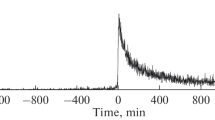Abstract
The Omori law for repeated underground shocks after a large earthquake is written here in the form of a nonlinear differential equation. We define a coefficient of deactivation for the rupture zone after the main shock. Two advantages of the new formulation are pointed out. First, there is now an interesting possibility for a natural incorporation of exogenous and endogenous factors that affect the rupture zone. We highlight endogenous triggers in the form of a circumnavigating seismic echo and free oscillations of the Earth excited by the main shock. The other advantage consists in the fact that the differential equation for aftershocks enables us to formulate the inverse problem for the physics of the rupture zone. The inverse problem reduces to the determination of the coefficient of deactivation based on observed aftershock frequency. Examples are given to illustrate the solution of the inverse problem. We propose to develop an atlas of aftershocks based on the solution of the inverse problem for the rupture zone that is “cooling” after a large earthquake.


Similar content being viewed by others
REFERENCES
Guglielmi, A.V., The Omori law (from the history of geophysics), Uspekhi Fizicheskikh Nauk, 2017, vol. 187, no. 3, pp. 343–348.
Guglielmi, A.V., Fitting empirical formulas to aftershocks: For the 150th anniversary of Fukasichi Omori, Report at the Council of the Institute of Physics of the Earth, October 24, 2018.
Guglielmi, A.V. and Zavyalov, A.D., The Omori law: The 150-year birthday jubilee of Fusakichi Omori, J. Volcanol. Seismol., 2018a, vol. 12, no. 5, pp. 353–358.
Guglielmi, A.V. and Zavyalov, A.D., The 150th Anniversary of Fusakichi Omori, European Seismological Commission 36th General Assembly, 2‒7 September 2018b, Valletta – Malta.
Guglielmi, A.V. and Zavyalov, A.D., The 150th anniversary of Fusakichi Omori (1868‒1923), IASPEI Newsletter, September 2018c, pp. 5‒6. http://ftp.iaspei.org/pub/newsletters/2018c/2018-September.pdf
Guglielmi, A.V and Zotov, O.D., On a hidden periodicity of earthquakes, Fizika Zemli, 2013, no. 1, pp. 3–10.
Guglielmi, A.V., Zotov, O.D., and Zavyalov, A.D., The dynamics of aftershocks following the Sumatra–Andaman earthquake, Fizika Zemli, 2014, no. 1, pp. 66–74.
Guglielmi, A.V., Zotov, O.D., and Zavyalov, A.D., Aftershocks atlas: To the 150th anniversary of Fusakichi Omori, 12th International Conference and School “Problems of Geocosmos”, Book of Abstracts, St. Petersburg, Petrodvorets, October 8–12, 2018. St. Petersburg, 2018. pp. 121.
Omori, F., On the aftershocks of earthquakes, J. Coll. Sci. Imp. Univ. Tokyo, 1894, vol. 7, pp. 111–200.
Utsu, T., A statistical study on the occurrence of aftershocks, Geophys. Mag., 1961, vol. 30, pp. 521–605.
Utsu, T., Ogata, Y., and Matsu’ura, R.S., The centenary of the Omori formula for a decay law of aftershock activity, J. Phys. Earth, 1995, vol. 43, pp. 1‒33.
Zavyalov, A.D., Guglielmi, A.V., Zotov, O.D., and Lavrov, I.P., Deviation from the Omori law as the result of the trigger impact of round-the-world surface seismic waves on the source of strong earthquakes, International Symposium on Deep Earth Exploration (DEEP-2018), Beijing, China, October 24‒26, 2018, Acta Geologica Sinica (English Edition), 2018, vol. 92, Suppl. 1, pp. 271.
Zavyalov, A.D., Zotov, O.D., and Klain, B.I., Space–time structures of aftershock sequences, in 5th Intern. conf. Triggernye effekty v geosistemakh (Trigger Effects in Geosystems), Abstracts of reports, Moscow: IDG RAN, 2019, pp. 72–73.
Zotov, O.D., Zavyalov, A.D., Guglielmi, A.V., and Lavrov, I.P., On the possible effect of circumnavigating seismic surface waves in the dynamics of aftershocks following large earthquakes, Fizika Zemli, 2018a, no. 1, pp. 187‒201.
Zotov, O.D., Zavyalov, A.D., and Klain, B.I., On the spatial-temporal structure of aftershock sequences, Proceedings of the 12th Int. School and Conference “Problems of Geocosmos”, October 08‒12, 2018, St. Petersburg, 2018b.
ACKNOWLEDGMENTS
We wish to express our sincere gratitude to B.I. Klain and A.S. Potapov for their interest in the present study and for a discussion of the aftershock problem.
Funding
This work was financially supported in part by Program 12 of the Presidium of the Russian Academy of Sciences and by the Russian Foundation for Basic Research, project no. 18-05-00096, as well as by programs of state assignments at the Institute of Physics of the Earth, Russian Academy of Sciences.
Author information
Authors and Affiliations
Corresponding author
Additional information
Translated by A. Petrosyan
Rights and permissions
About this article
Cite this article
Guglielmi, A.V., Zavyalov, A.D. & Zotov, O.D. A Project for an Atlas of Aftershocks Following Large Earthquakes. J. Volcanolog. Seismol. 13, 415–419 (2019). https://doi.org/10.1134/S0742046319060034
Received:
Revised:
Accepted:
Published:
Issue Date:
DOI: https://doi.org/10.1134/S0742046319060034




